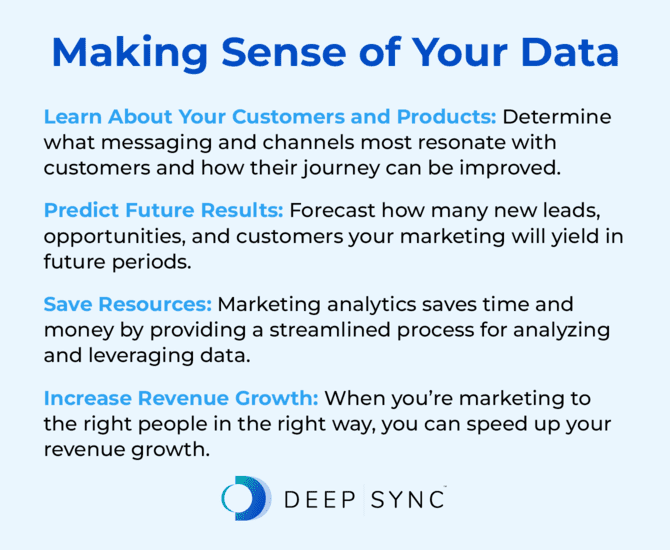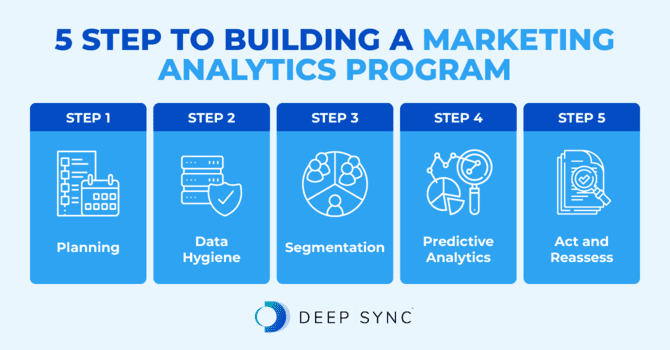In 1865, banker Sir Henry Furnese analyzed his promotional data to win over customers and outwit his competitors in one of the first documented instances of marketing analytics. While today’s marketing analytics processes have become much more complex than those used by Furnese, often tracking individual consumer behavior across a range of channels and interactions, it continues in the same tradition of leveraging past consumer data to guide future marketing decisions.
Considering this history, in this guide, you’ll learn the most current practices of marketing analytics alongside the steps to establishing a successful marketing analytics program for your business. We’ll cover the following topics:
- What Is Marketing Analytics?
- Primary Goals of Marketing Analytics
- 4 Benefits of Predictive Analytics
- Key Methods of Marketing Analytics
- How to Build a Marketing Analytics Program: 5 Steps
- Choosing a Marketing Analytics Provider
If you’re interested in diving into a particular topic, use the table of contents above to jump directly to that section. Otherwise, let’s begin by focusing on the contemporary definition of marketing analytics and the elements that make it the powerful tool it is today.

What Is Marketing Analytics?
Marketing analytics leverages predictive modeling, artificial intelligence, and machine learning to study consumer data, identify patterns, predict future consumer behavior, and optimize the return on investment of a marketing campaign.
Today’s analytics look to make sense of a vast ocean of data, including conversion and clickthrough rates, consumer demographics, online activity, and regional and creative preferences. By continuously tracking and reporting on consumer data, marketing professionals can make decisive conclusions about the impact of their marketing activities and what to do next.
Primary Goals of Marketing Analytics
Across businesses and sectors, marketing analytics can be broken down into two primary goals: to gauge how well efforts have performed so far and to determine what to do differently going forward.
While it’s a good idea to keep these overarching goals in mind when considering marketing analytics for your business, you’ll likely want to get more specific about how it applies to your business. When assessing what you want from your marketing analytics program, you should define the questions you’re hoping it will answer. Your questions might include:
- How are our marketing activities currently performing?
- How have our marketing activities performed historically?
- What can we do to improve our marketing activities?
- How do our marketing activities compare with our competitors?
- How can our marketing resources be more effectively allocated?
- Where should we be devoting more time and money?
Once you determine your questions, you’ll also need to decide what metrics will lead you to a clear answer. For this strategy to work, these metrics need to be measurable, specific, and timely. If they’re vague or too broad, you won’t be able to draw meaningful conclusions from your data. Remember, correlation does not equal causation!
4 Benefits of Predictive Analytics
If the overall goal of marketing analytics is to use data to understand your past marketing behavior and make future activities more effective, achieving these goals translates to four practical benefits for your marketing activities. With a robust marketing analytics program, you can learn about your customers and products, predict future results, save resources, and increase revenue growth.

1. Learn about your customers and products.
Marketing analytics can help you better understand your customers and how they view your products and services. Analyze your data to gain insight into the following customer- and product-related questions:
- What messaging most resonates with them?
- What marketing channels are they most receptive to?
- Which product or services are they buying?
- What features do they find most attractive?
- What features do they want in future products?
As consumers have become more and more selective in where they spend their money, it’s essential to know how to earn their loyalty and make targeted appeals to their individual interests.
2. Predict future results.
With marketing analytics, your data can help you predict your best future customers, anticipate how they’ll respond to your messaging, and forecast how many new leads, opportunities, and customers you’ll acquire in upcoming periods. For instance, by analyzing cart abandonment data from previous campaigns, you might find that your customers are more likely to complete a purchase during certain times of the year. Using that knowledge, you can create a more accurate quarterly budget and plan for short- and long-term growth.
3. Save resources.
Marketing analytics can save your organization time and money by providing a streamlined process for analyzing and leveraging data. Instead of wasting staff time and resources trying to manage, analyze, and leverage consumer data manually, utilize a marketing analytics company to take on the heavy lifting.
As a result, you’ll be able to understand your customers better and tailor your marketing outreach to their needs, preferences, and interests. For example, if you find your target customers are most responsive to email messaging, you could then decrease your spending on social media and direct mail marketing channels. In this sense, analytics can help you identify and respond to anticipated market changes as well as simplify product and customer-facing processes for increased efficiency and effectiveness.
4. Increase revenue growth.
Ultimately, each of the above improvements translates to increased revenue for your business. When you’re marketing to the right people in the right way, you can take in more money and speed up your growth, reaching new audiences, offering new services or products, and hiring additional staff.
Key Methods of Marketing Analytics
Marketing data analysis can take a variety of forms. In general, these will depend on the campaign’s key metrics, such as conversions or brand awareness, that are set when defining your goals. You can use four main methods to analyze your marketing data:
- Method 1: Single Attribution Analysis (SAA). Single attribution analysis is one of the most ubiquitous marketing analytics strategies. With this method, you attribute a buyer’s purchasing decision to a single touchpoint, such as a social media post, a landing page, or an email. Generally, SAA focuses on your business’s first or last interaction with a customer before buying.
- Method 2: Multi-Touch Attribution (MTA). Unlike SAA, MTA looks at every marketing touch a consumer has with your business alongside that touch’s weighted value to take a more holistic picture of consumer data.
- Method 3: Media Mix Modeling (MMM). For an even more holistic view, MMM looks at both long-term marketing- and non-marketing-related data, including economic and socio-political conditions, pricing, and product features. While this can produce highly impactful insights, because of its complexity, it also requires a significant investment of resources.
- Method 4: Unified Marketing Measurement (UMM). Finally, as the name suggests, UMM combines the three above models into a comprehensive analysis across channels and engagements.
Ultimately, choose the model that best aligns with your available resources and your specific marketing goals. For example, if you’re interested in the impact of a particular customer interaction on your brand awareness, you might employ a single attribution analysis. On the other hand, to understand the impact of an entire two-year-long campaign, you might use media mix modeling or unified marketing measurement.
How to Build a Marketing Analytics Program: 5 Steps
Are you ready to bring marketing analytics to your company? Great! We’ve broken down the process into five simple steps: planning, data hygiene, segmentation, predictive analytics, and act and reassess. To build a strong marketing analytics program, you will want to dedicate time and energy to following these steps.

Step 1: Planning
With so much data, it can be easy to get lost along the way. Before getting started, you’ll want to develop a defined plan and strategy for your marketing analytics program.
Several steps go into the planning stage of marketing analytics. These include:
- Assess your current capabilities. Determine where you’re already successful in your analytics process and the gaps that need to be filled.
- Set goals, targets, and benchmarks. Refer to your goals and benchmarks throughout the analytical and marketing process.
- Specify your questions, analytics method, and metrics. For an informative analytics program, these should directly address your goals and targets.
- Choose your tools. Luckily, there’s technology for nearly every marketing analytics program. Based on your marketing analytics needs, choose tools that will help you work more efficiently and effectively.
While your plan should be detailed and precise, it shouldn’t be set in stone. As much as we’d like to predict every outcome, unforeseen circumstances are a regular feature of our world. After starting your marketing analytics program, you may find that you need to adjust your plan according to direct and indirect factors.
Step 2: Data Hygiene
Once you have your plan in place, you’ll want to implement data hygiene procedures to ensure that the data you’re using is accurate and up-to-date. Inaccurate data will inevitably lead to poor or flat-out wrong insights and has been shown to cost organizations up to 12% in revenue per year.
Thus, correct the following types of data in your consumer database:
- Duplicate entries
- Out-of-date entries
- Inaccurate entries
- Incomplete entries
Additionally, you might append missing or incomplete data with third-party data from a trusted provider. Instead of trying to maintain your database manually, a provider can help you implement automatic database management processes. For example, whenever a new customer is added, a provider can cross-reference the customer’s information with additional datasets and add data points to the customer’s profile.
Ultimately, your analytics are limited by the quality of your data. Thus, beyond a single cleaning, it’s important to ensure that you continuously maintain data hygiene best practices with your customer database.
Step 3: Segmentation
Next, in order to focus on the most relevant data, segment your consumer information into groups according to their relevant qualities, interests, behaviors, and demographics. You might create segments based on:
- Purchase history
- Age
- Gender
- Education
- Income
- Email click-throughs
- Religion
- Location
- Shopping cart abandonment
With your segments, create a set of typical customer profiles, each of whom you’ll target differently. Ultimately, instead of forcing you to wade through all your data at once, segmentation allows you to filter for what’s relevant and ignore what’s not.
Step 4: Predictive Analytics
Once your database is cleaned and segmented, you can use your existing data to predict and influence future customer behavior, including identifying ideal prospects, predicting customer churn, developing new segments, or evaluating a customer’s lifetime value. While predictive analytics can be conducted via standard algorithms, more advanced programs use custom modeling solutions that address a business’s unique circumstances.
Step 5: Act and Reassess
Finally, apply the results of your predictive analytics from Step 4 to your marketing plan and decisions. For example, you might need to change the timing of your appeals to hesitant customers, advertise lower-cost products, or use a different marketing medium entirely.
But don’t stop there! Continue to reassess as you adjust goals and circumstances change. In addition to predicting future consumer behavior, you’ll also want to report on past and present activities to determine if your actions are going according to plan. By approaching your marketing analytics as a cyclical process, you’ll increase your company’s profitability and earn your customers’ trust and loyalty.
Choosing a Marketing Analytics Provider
With so much data, these steps to building a marketing analytics program can quickly become quite messy. Marketing analytics tools and software help marketing professionals collect, organize, correlate, and, ultimately, act on consumer data.
When choosing a marketing analytics provider, make sure they offer the following tools and services for the greatest impact:
- Comprehensive data-driven products and services. Choose a company that offers a range of services, including targeted data solutions, custom predictive modeling, customer profiling, email and digital marketing, and custom database hygiene services.
- Real-person expert knowledge. You shouldn’t be expected to make sense of all your consumer data on your own. That’s why you should look for a company that offers on-call experts. For example, Deep Sync’s team provides over 30 years of real-world marketing analytics experience.
- Customizable reports. Not only should you be able to create reports that are specific to your unique goals, but also to your business’s overall strategy and long-term needs.
Since your data are one of the most—if not the most—important assets to your marketing program, take your time choosing a company you trust. To determine the right fit, don’t be afraid to ask in-depth questions about their company values and policies as well as review their customer testimonials.
Additional Resources
Ready to learn more about marketing analytics? Deep Sync has several resources and guides to help you launch and improve your marketing analytics:
- The Ultimate Digital Marketing Guide to Increase Your Reach. Marketing analytics is just a portion of the larger digital marketing ecosystem. Follow this guide to learn more about other critical components of digital marketing.
- Database Marketing Services: The Key to a Higher ROI. Interested in how other businesses have leveraged data analytics to their advantage? Learn from these examples of successful analytics initiatives.
- Customer Profiling and Analytics: Unlock New Insights. Marketing analytics isn’t always easy. Luckily, you don’t have to do it alone. Use this page to navigate Deep Sync’s solutions.













0 Comments